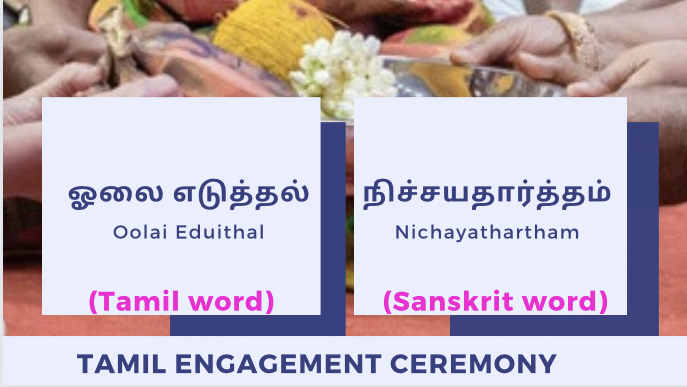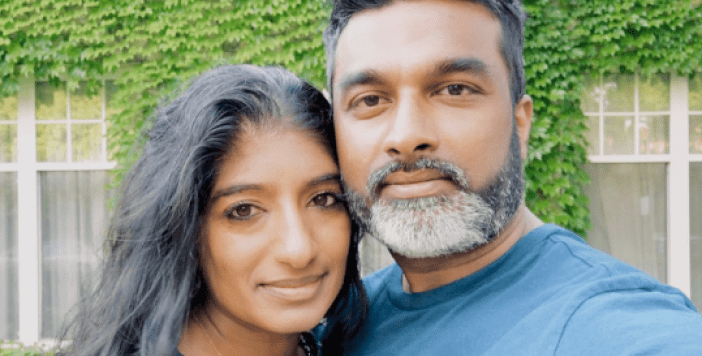
Date on your own terms! myTamilDate has been the most trusted dating community for single Tamils around the world for close to a decade! We’re the premiere dating site for diaspora Tamils and have the largest membership base in Canada, USA, UK & more. JOIN TODAY: https://mytamildate.com/
Meet our latest couple Madhu & Niya:
____
வணக்கம் (vanakkam), it’s @whatthepottu again. As you may recall from my previous articles, I am currently writing a series on ancient Tamil wedding practices. In fact, I created a version of Tamil wedding rituals that I believe celebrates the nature-oriented worship of our Tamil ancestors.
One of the areas I researched is the pre-wedding rituals. Specifically, how did ancient Tamils conduct engagement ceremonies?
The union between two families have been an essential part of Tamil weddings and continues to be so. There are references in ancient Tamil literature that elaborate on two families (the families of the bride and groom) gathering around the village and announcing their approval of the union. On a palm leaf, the families formally provided a written statement that they approved the marriage and set a wedding date. Our ancestors referred to this ceremony as “ஓலை எடுத்தல்” (Oolai Eduithal).
Oolai” refers to dried palm leaves. As manuscripts used to be written on dried palm leaves, Oolai Eduithal can be loosely translated as “providing written oath on dried palm leaves”.
There is an abundance of references to the lives of our ancestors in ancient Tamil literature. Interestingly, a poem in “Aintinai Eḻupatu” (an ancient Tamil text), discusses the type of written oaths exchanged by couples of that time. Specifically, in Aintinai Eḻupatu (stanza 44 - see original Tamil version below).
The heroine expresses her agony to a friend–she is hurt because her husband is at a sex worker’s house. As she believed all his sweet promises when they were lovers, she didn’t think it was necessary to have him write down all his promises on their written oath before marriage. The heroine now regrets that decision.
From this poem, scholars infer that along with parental and village approval, the couple also provided their consent to the marriage with specific oaths attached to the union.
You may be familiar with a slightly similar version of an engagement ceremony called “nichayathartham”. But did you know this is not a Tamil but a Sanskrit word?
Check out myTamilDate's 'Dating While Tamil' podcast:
“ஓலை எடுத்தல்“ (Oolai Eduithal) is the Tamil word for this ancient Tamil engagement ceremony. If you want to use a Tamil word for this ceremony, try saying “ஓலை எடுத்தல்”(Oolai Eduithal) from now on.
For the weddings that I conducted, I requested both families to exchange trays and verbally state their approval of the union. I also ensured that the couple had an equal opportunity to consent to the marriage–more on this later.
What do you think about this form of engagement ceremony?
Tamil lines of the poem referred to above - Aintinai Eḻupatu
ஒள்ளிதழ்த் தாமரைப் போதுறழும் ஊரனை
உள்ளம்கொண்டு உள்ளானென்று யார்க்குரைக்கோ - ஒள்ளிழாய்
அச்சுப் பணிமொழி உண்டேனோ மேனாளோர்
பொய்ச் சூள் எனவறியா தேன் (பா.44)
References
-
ஐந்திணை எழுபது கூறும் சங்க காலத் திருமணம் by கி. இராம் கணேஷ்
-
உறுதிமொழிப் பத்திரம் by முனைவர் கி. இராம்கணேஷ்;
-
தமிழர் திருமணம் by சசிவல்லி
To learn more about ancient Tamil customs and practices follow @whatthepottu: https://www.instagram.com/whatthepottu/?hl=en
Check out myTamilDate's 'Dating While Tamil' podcast:

























